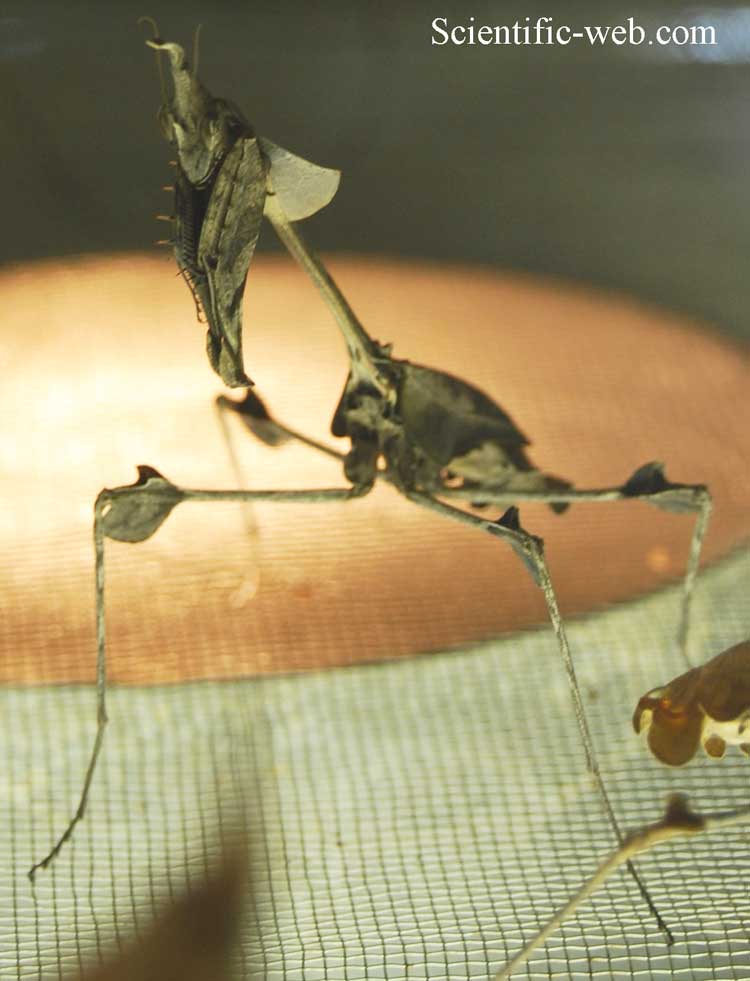
Gongylus gongylodes, Photo: Michael Lahanas
Superregnum: Eukaryota
Regnum: Animalia
Subregnum: Eumetazoa
Cladus: Bilateria
Cladus: Nephrozoa
Cladus: Protostomia
Cladus: Ecdysozoa
Cladus: Panarthropoda
Phylum: Arthropoda
Subphylum: Hexapoda
Classis: Insecta
Cladus: Dicondylia
Subclassis: Pterygota
Cladus: Metapterygota
Infraclassis: Neoptera
Supercohort: Polyneoptera
Cohort: Dictyoptera
Ordo: Mantodea
Familia: Empusidae
Subfamilia: Empusinae
Tribus: Empusini
Genus: Gongylus
Species: Gongylus gongylodes
Name
Gongylus gongylodes (Linnaeus, 1758)
Synonyms
Gryllus gongylodes Linnaeus, 1758
References
Primary references
Linnaeus, C. 1758. Systema Naturae per regna tria naturæ, secundum classes, ordines, genera, species, cum characteribus, differentiis, synonymis, locis, Tomus I. Editio decima, reformata. Holmiæ: impensis direct. Laurentii Salvii. i–ii, 1–824 pp DOI: 10.5962/bhl.title.542: 426. Reference page.
Links
Gongylus gongylodes in the Mantodea Species File database, accessed on 13/10/2013.
ZooBank: 87E83B5F-F7E9-45C5-BD14-ED815C897186
Vernacular names
English: Wandering Violin Mantis
Gongylus gongylodes, also known as the wandering violin mantis, ornate mantis, or Indian rose mantis, is a species of praying mantis in the family Empusidae. Characterized by extremely slender limbs with large appendages, it is not a particularly aggressive species and often kept as a pet by hobbyists. The mantis is especially known for swaying its body back and forth to imitate a stick flowing in the wind.[1] It primarily feeds on flying insects. Its native range is in southern India and Sri Lanka. It can reach up to 11 cm long. The males of the species are capable of flight. This species is a communal species in that they live and breed in large groups without unnecessary cannibalism.
Its specific name gongylodes means "roundish" in Greek,[2] from the same word as its generic epithet Gongylus.
Copy of the original description of several species of mantis including Gongylus gongylodes, described by Carl Linnaeus as Gryllus (Mantis) gongylodes in 1758.
Range
They are found in India, Java, Myanmar, Sri Lanka, and Thailand.[3] Mi
References
French, Jess. Minibeasts with Jess French: Masses of Mindblowing Minibeast Facts! Bloomsbury Wildlife, 2018.
Stearn, William Thomas (1983). Botanical Latin. 275. David & Charles. ISBN 978-0-7153-8548-7. "gongylodes / gongyloides: roundish"
Texas A&M University
Retrieved from "http://en.wikipedia.org/"
All text is available under the terms of the GNU Free Documentation License

